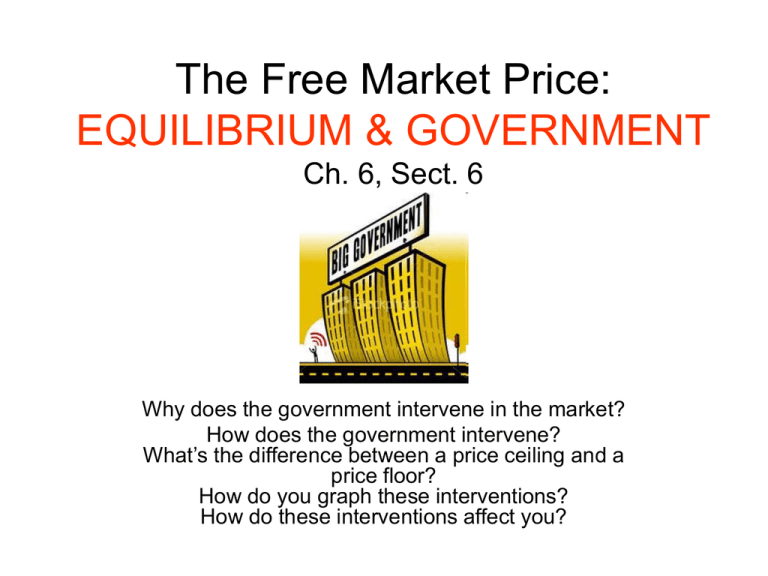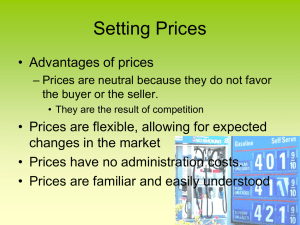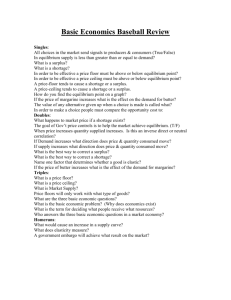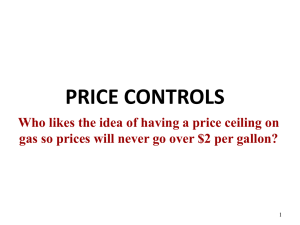The Free Market Price: EQUILIBRIUM & GOVERNMENT Ch. 6, Sect. 6
advertisement

The Free Market Price: EQUILIBRIUM & GOVERNMENT Ch. 6, Sect. 6 Why does the government intervene in the market? How does the government intervene? What’s the difference between a price ceiling and a price floor? How do you graph these interventions? How do these interventions affect you? Why do governments get involved in a market? • Usually, when prices can freely rise/fall to equilibrium, they best allocate scarce resources • Sometimes, governments intervene in the market in an attempt to influence prices • They do this with price controls: placing limits on how high or low certain prices may be • Government usually uses price controls when they believe supply and demand will result in prices that are unfairly high for consumers or unfairly low for producers. – 1970s the U.S. government imposed price controls on gas in response to reduced shipments of foreign oil due to crises in the Middle East. • to protect consumers from price swings • imposed price controls during wars in attempts to ensure that goods are distributed fairly during periods of shortage • Governments can control prices in two ways: by setting price floors or price ceilings – both methods affect supply and demand What is a price floor? • When a government wants to keep prices from going too low, it sets a price floor: a minimum price consumers are required to pay for a good or service. – A price at or above a price floor is legal, while a price below the price floor is illegal. – Price floors are meant to push prices up, ensuring that producers receive a benefit for providing a good or service. – Pressure for price floors happens when producers feel the market isn’t providing them with adequate income (equilibrium price is too low). • Another price floor is minimum wage: a government-imposed legal floor on the hourly wage rate (price the market pays for labor). – where workers outnumber jobs, supply and demand would drive the equilibrium wage so low that many workers would be earning too little to live decently • While price floors may benefit some people, the larger effect of a price floor is excess supply How does the price floor affect the Qs of workers? How does it affect the Qd of workers? Is the result a shortage or surplus? How do you find out? What is a price ceiling? • When a government wants to keep prices from going too high, it sets a price ceiling: a maximum price consumers may be required to pay for a good or service. – A price at or below a price ceiling is legal. A price above the ceiling is not legal. • Price ceilings are used to help consumers to buy essential goods/services they wouldn’t be able to afford at the equilibrium price. – Usually created in response to a crisis, such as war, natural disaster, or widespread crop failure. • The best-known form of price ceilings is rent control: regulations that make it illegal to charge more than a specified monthly amount for rental housing. – In NYC, rent control was introduced during World War II to protect poor families; today, 2.5 million New Yorkers live in rent-regulated apartments How does the price ceiling affect Qd of apartments? Qs of apartments? Is there a shortage or surplus? How do you know? What are the lasting effects? Price controls lead to surpluses and shortages; they prevent markets from reaching equilibrium • The excess supply and demand that arise must be addressed outside the market. This happens in various ways: • In the case of an agricultural surplus from price floors, the government may limit supply by restricting how much farmers grow, or buy surplus at the price floor for later use or to give as foreign aid – Such aid often works against farmers in countries that cannot compete with cheap American surplus grain • When shortages occur, the government may use rationing: the controlled distribution of a limited supply of a good or service – 1973 oil crisis: price ceilings led to a severe gas shortage, so a rationing system based on license plate numbers was created to help with shortage – Rationing is a costly way of allocating scarce goods • Shortages can also give rise to black markets: illegal markets in which goods are traded at prices or in quantities higher than those set by law – There was a thriving black market during World War II for meat, sugar, and gasoline… Check yourself! • Explain the difference between a price ceiling and price floor. • What results as a result of shortages? • Why does the government impose (create and enforce) price controls on the market? • What happens to equilibrium with a price ceiling? • What happens to equilibrium with a price floor? • Explain what kind of price control is illustrated above.











